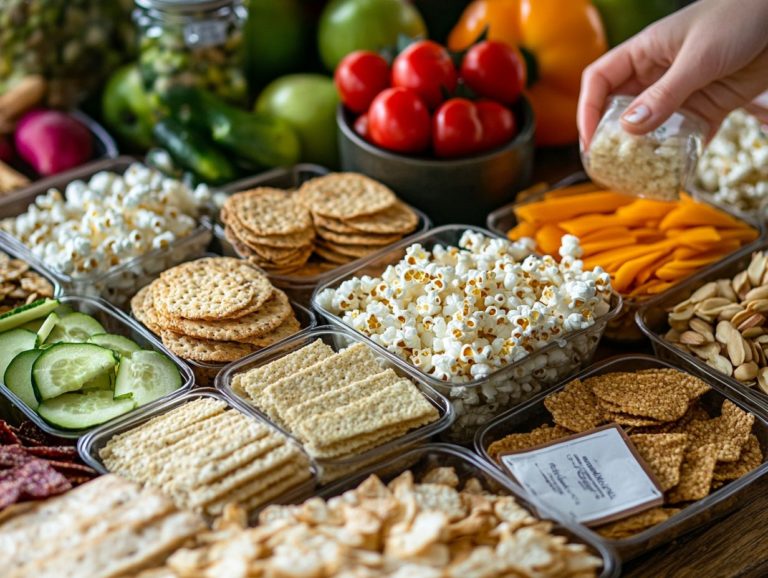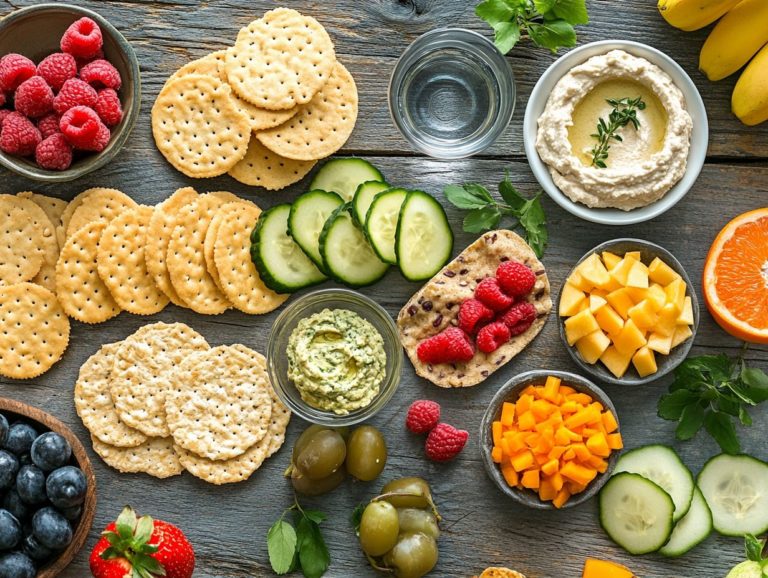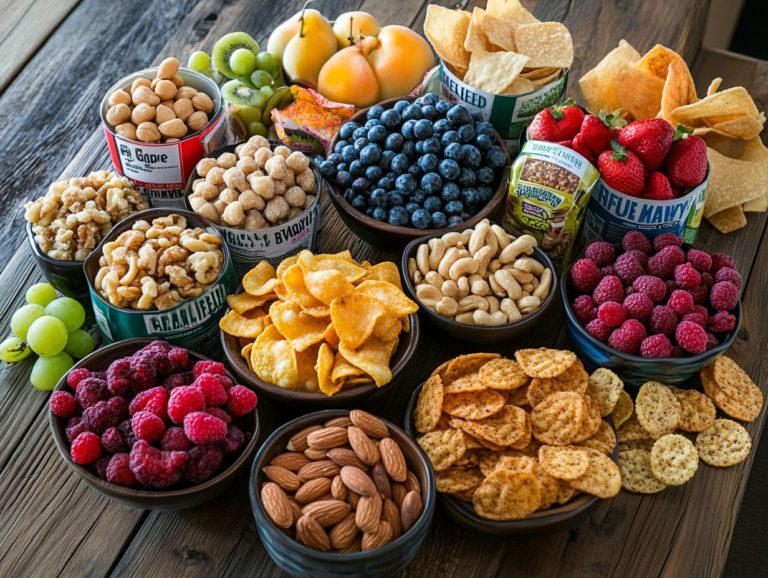What Ingredients to Avoid in Gluten-Free Snacks?
Navigating the world of gluten-free snacks can be quite a challenge, particularly with the plethora of enticing options that may not be as safe as they appear. Understanding which foods and ingredients to avoid is crucial for maintaining a healthy diet, especially for those with celiac disease or non-celiac gluten sensitivity.
To make informed choices, it s crucial for you to know which common ingredients to steer clear of. From hidden sources of gluten such as wheat, barley, and rye to unexpected culprits lurking in sauces, medications, and snacks, this guide will highlight must-know ingredients so you can snack worry-free!
Moreover, you ll discover a selection of delectable gluten-free snack alternatives, including those from brands like Simple Mills and Purely Elizabeth, that will keep your taste buds happy while meeting your dietary needs. Immerse yourself in this exploration to ensure your snacking remains both safe and delightful!
Contents
- Key Takeaways:
- What Are the Common Ingredients to Avoid in Gluten-Free Snacks?
- What Are Some Gluten-Free Snack Options?
- Frequently Asked Questions
- What ingredients should I avoid when looking for gluten-free snacks?
- Are there any additives or preservatives that should be avoided in gluten-free snacks?
- Is it safe to assume that all gluten-free snacks are free of cross-contamination?
- What about hidden sources of gluten in gluten-free snacks?
- Are there any specific types of gluten-free snacks that I should be aware of?
- Can I trust products labeled as “gluten-free” from other countries or regions?
Key Takeaways:
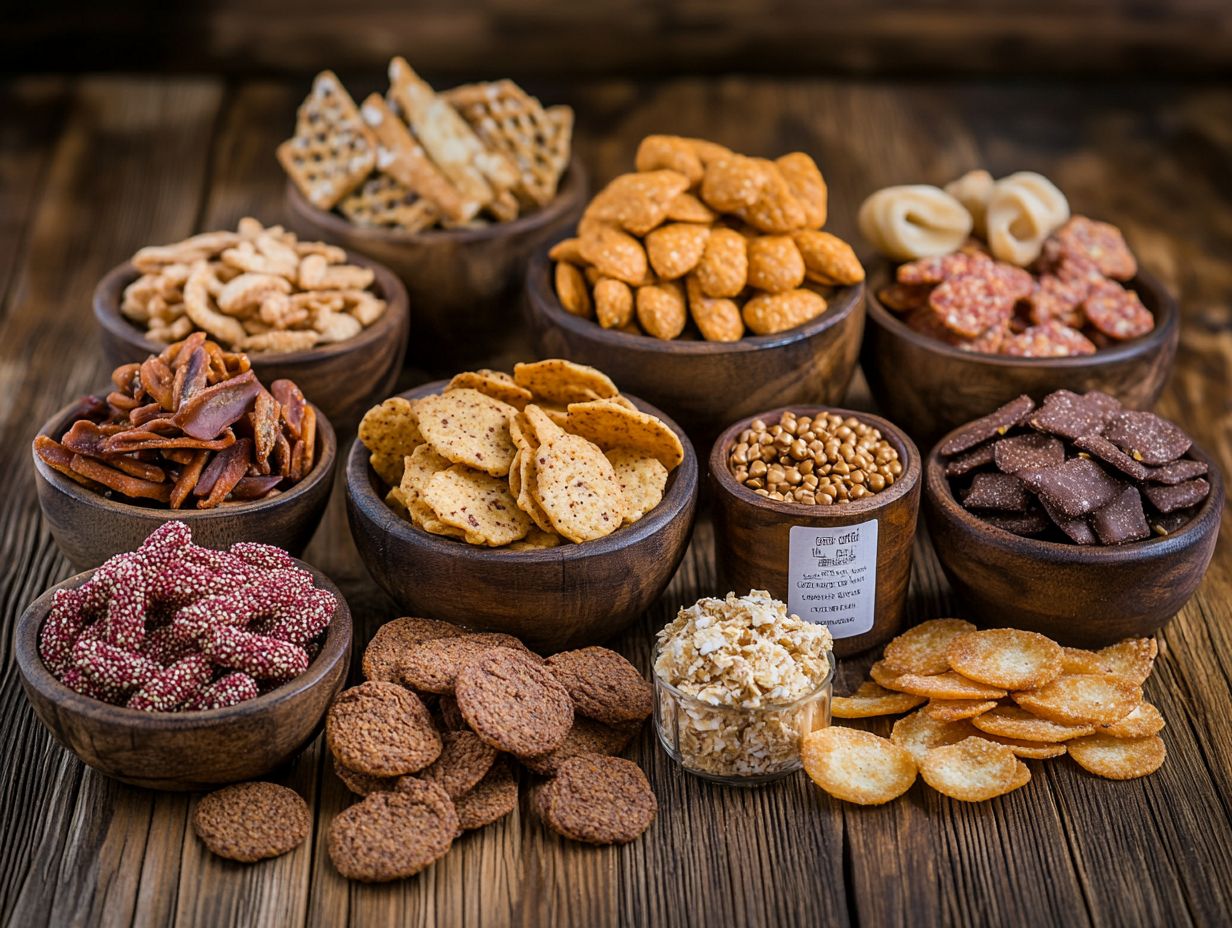
- Avoid wheat, barley, rye, oats, malt, soy sauce, modified food starch, hydrolyzed vegetable protein, dextrin, and brewer’s yeast in gluten-free snacks.
- Opt for gluten-free snack options like fruits, vegetables, nuts, seeds, legumes, crackers, chips, rice cakes, and granola bars.
- Always read labels and look for certified gluten-free logos from authorities like the FDA and USDA to ensure the snacks are free of any harmful ingredients.
What Are the Common Ingredients to Avoid in Gluten-Free Snacks?
When you embark on the journey of exploring gluten-free snacks, it s essential to grasp the common ingredients you need to steer clear of to uphold a healthy diet, especially if you have celiac disease or non-celiac gluten sensitivity. Always be vigilant about avoiding gluten in your foods and beverages, and read labels carefully.
Gluten, a protein lurking in wheat, barley, and rye, can unexpectedly find its way into processed foods due to cross-contamination (the unintentional mixing of gluten-containing ingredients) during manufacturing. To truly protect your dietary needs, you must diligently read labels, identifying any hidden gluten ingredients that could compromise your well-being.
Be aware of gluten-free products from well-known brands like Bob s Red Mill.
1. Wheat
Wheat stands as one of the most prevalent grains containing gluten, making it imperative for you to avoid it entirely in a gluten-free diet, particularly if you ve been diagnosed with celiac disease, as it can provoke severe symptoms.
It’s equally important to be aware of the various forms this grain can take, such as whole wheat, wheat flour, and refined wheat products. These forms are commonly found in an extensive range of food items, including bread, pasta, and pastries.
For those who must eliminate gluten from their diets, examining labels becomes essential. Many products that appear safe can harbor hidden wheat derivatives, potentially triggering adverse reactions. This attentiveness is crucial not just to spare yourself discomfort, but to safeguard your overall health, as gluten sensitivity can lead to long-term health issues if overlooked.
2. Barley
Barley is another grain that contains gluten and should be avoided if you re following a gluten-free diet, as even trace amounts can trigger adverse health effects. This is supported by guidelines from health organizations like the Mayo Clinic.
This means you ll need to be particularly vigilant when selecting products; checking the ingredient list is essential. Barley is often found in malt beverages and cereals thanks to its robust flavor and fermentation properties, which explains why many snacks might unknowingly include this ingredient.
With gluten-free diets gaining popularity, it’s vital for you to scrutinize the gluten content in processed foods to ensure you’re not unintentionally consuming barley or its derivatives. By taking these precautions, you can manage your dietary restrictions more effectively while still enjoying a wide variety of food options.
3. Rye
Rye, much like wheat and barley, contains gluten and poses a significant risk for anyone with celiac disease. This makes it essential for you to avoid any products that include this grain.
However, rye boasts a fascinating range of culinary applications that many find enticing. Take, for instance, traditional rye bread, known for its denser texture and robust flavor that stand out in contrast to its wheat counterparts. Additionally, rye plays a pivotal role in crafting whiskey, particularly in varieties like rye bourbon and rye whiskey, where it imparts a distinctive spicy character to the spirit.
If you’re on the lookout for gluten-free options, it’s crucial to scrutinize food labels meticulously. Rye and its derivatives can often sneak into snacks, processed foods, and even certain types of alcohol under various aliases, underscoring the necessity of vigilance in your dietary choices.
4. Oats
Oats are often hailed as a wholesome grain, but if you have celiac disease, they can present challenges due to the risk of cross-contact with gluten-containing grains during their growth and processing.
For those adhering to a strict gluten-free diet, it s crucial to grasp the difference between certified gluten-free oats and regular oats. Certified gluten-free oats are cultivated, processed, and packaged in a way that eliminates the risk of cross-contamination, making them a much safer choice.
Always take the time to scrutinize labels to ensure the oats you select are clearly marked gluten-free, as not all brands adhere to the same stringent standards. Even a trace amount of gluten can trigger a reaction in individuals with celiac disease, so being mindful of brand reputation and product selection is vital for safeguarding your health and well-being.
5. Malt
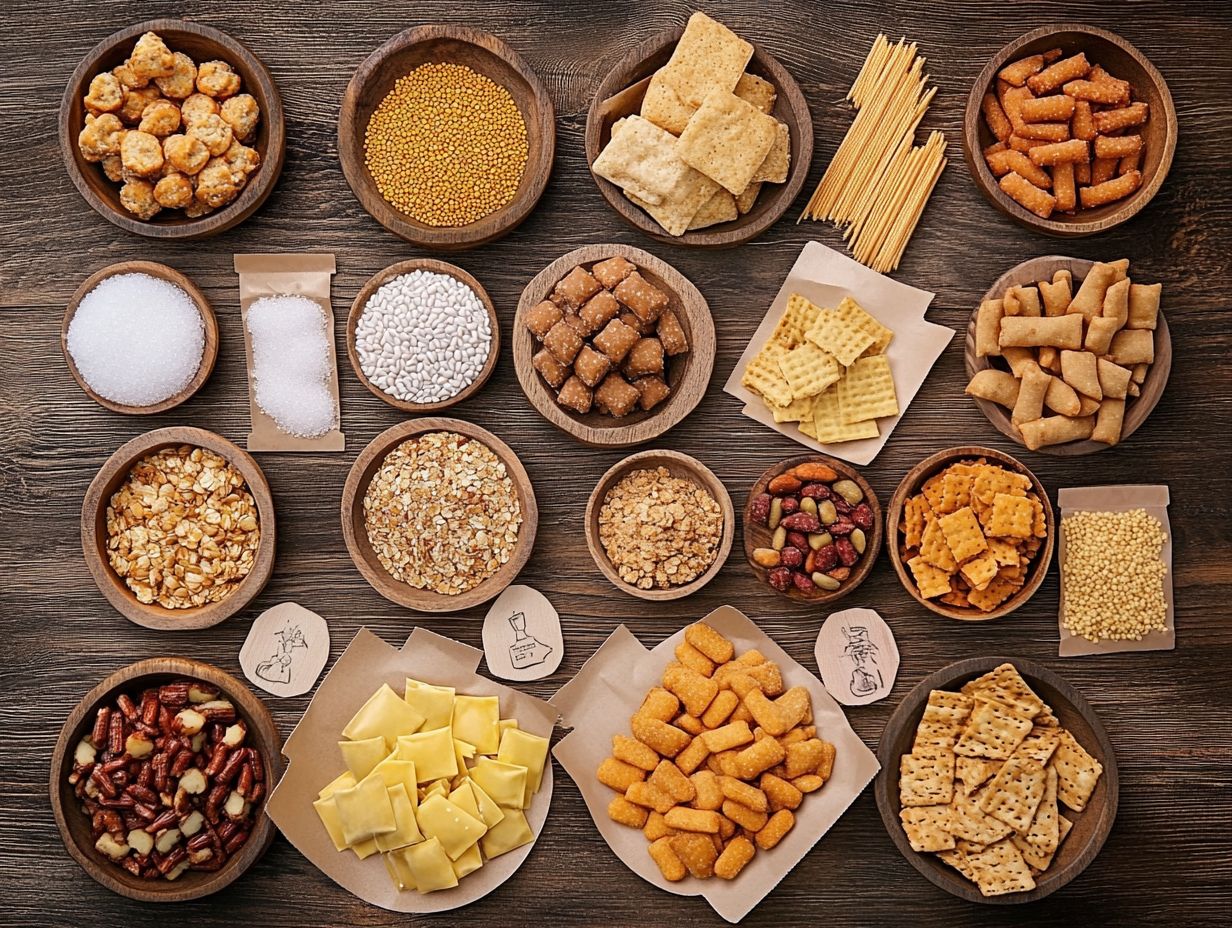
Malt, derived from barley, is a common ingredient found in numerous snacks and beverages. However, it’s important to note that it contains gluten, making it unsuitable for individuals with celiac disease.
Beyond its role in traditional products, malt appears in various forms, such as malt extract, frequently used as a sweetener in baked goods, and malt vinegar, a beloved staple in salad dressings. Some snacks even incorporate malted barley for its flavor or as a binding agent, which can pose potential risks for those who must avoid gluten.
Consequently, it s essential for you to scrutinize labels with care, particularly when selecting gluten-free snacks. Ensuring that malt isn t an inadvertently included ingredient is vital to safeguarding your health and well-being.
6. Soy Sauce
Soy sauce is typically crafted using wheat, which contains gluten, making it a potentially problematic ingredient for anyone adhering to a gluten-free diet, particularly individuals with celiac disease.
Fortunately, there are a plethora of gluten-free soy sauce alternatives available on the market today, designed specifically for those who need to avoid gluten yet still wish to enjoy the rich umami flavor that soy sauce offers. This is especially important when preparing dishes like stir-fries and sushi.
It s crucial for you to carefully examine product labels, as even trace amounts of gluten can provoke adverse reactions for those with sensitivities.
In both cooking and snacking, soy sauce elevates dishes ranging from stir-fries to sushi, adding depth and flavor. By embracing gluten-free alternatives, you can indulge in these culinary delights without compromising your health.
7. Modified Food Starch
Modified food starch can originate from various sources, including wheat, which means that it may contain gluten. This makes it imperative for individuals with celiac disease to scrutinize ingredients with great care.
For those on the hunt for safe snack options or processed foods, grasping the role of modified food starch is essential. This ingredient often acts as a thickening agent or stabilizer, enhancing both the texture and shelf life of a wide array of popular snacks, from savory sauces to delectable baked goods.
It s crucial to distinguish between gluten-free and gluten-containing versions of modified food starches. When navigating dietary restrictions, you should be diligent in examining labels and ingredient lists, as even trace amounts of gluten can pose significant health risks. This vigilance is particularly important when selecting convenience foods, where the presence of gluten may not be immediately apparent.
8. Hydrolyzed Vegetable Protein
Hydrolyzed vegetable protein is an ingredient you should be aware of. It can sometimes come from wheat, raising red flags for those with celiac disease.
Often found in various snacks to elevate flavor and texture, this ingredient introduces a significant risk for individuals with gluten sensitivities. Make it a habit to carefully check product labels your health depends on it! Many manufacturers may not provide clear indications of whether their products are gluten-free, which can inadvertently lead to health complications for those adhering to strict gluten-free diets.
Therefore, advocating for transparency in ingredient sourcing and testing is crucial. This ensures that snack options are both delightful and safe for everyone, especially those with dietary restrictions.
9. Dextrin
Dextrin can come from various starch sources, including wheat. This makes it a potential gluten source you ll want to avoid if you re following a gluten-free diet. This is especially important for individuals with celiac disease or gluten sensitivities since even trace amounts of gluten can provoke bad reactions.
You ll often find dextrin lurking as a thickening agent or filler in a range of snacks and processed foods, such as chips, cereals, and baked goods. If you re committed to a gluten-free lifestyle, it s essential to scrutinize product labels with care.
Look for gluten-free certifications from reputable sources like the FDA and USDA. Specifically, check for the absence of wheat derivatives in the ingredient list. Doing so can help you mitigate health risks while still enjoying a diverse array of food options.
10. Brewer’s Yeast
Brewer’s yeast is often linked to gluten-containing products, so it’s wise to approach it with caution if you have celiac disease. It could potentially expose you to gluten.
This is especially important for anyone sensitive to gluten since many food products such as certain beers and baked goods rely on brewer’s yeast for fermentation and rising. Therefore, it s essential for you to investigate the sourcing of brewer’s yeast in the items you consume.
Choose only those that are clearly labeled as gluten-free by trusted organizations like the Mayo Clinic. By being vigilant about the ingredients in your food choices, you not only protect your health but also enable yourself to enjoy a diverse diet without the constant concern of gluten contamination.
Understanding the processes and verifying claims on packaging can truly empower you as a consumer with gluten sensitivities.
What Are Some Gluten-Free Snack Options?

If you’re following a gluten-free diet, you’ll be delighted to discover a wealth of delicious snack options that allow you to indulge without sacrificing your health.
Fresh fruits and vegetables, naturally gluten-free, are packed with essential nutrients and make for satisfying snacks. You can also find many gluten-free products from reputable brands like Simple Mills, Purely Elizabeth, and Bob s Red Mill, which present enticing alternatives.
These choices enable you to maintain a balanced and healthy diet while steering clear of gluten-related issues.
1. Fruits and Vegetables
Fruits and vegetables are truly outstanding gluten-free snack options, brimming with vitamins, minerals, and fiber. They make for a wholesome choice for anyone keen on avoiding gluten.
Imagine indulging in crisp apple slices drizzled with almond butter or savoring refreshing cucumber sticks dipped in creamy hummus. These colorful, nutrient-dense delights offer a satisfying crunch and natural sweetness, effortlessly curbing your cravings.
Berries, such as strawberries and blueberries, are especially favored for their impressive antioxidant properties. Enjoy them on their own or blend them into a smoothie for a flavorful boost all without any gluten worries.
Consider crunchy carrots and vibrant bell pepper strips as perfect companions for guacamole. They deliver essential nutrients while keeping your snacking both enjoyable and nutritious. These options integrate seamlessly into your gluten-free lifestyle, ensuring that healthy choices remain delightful and effortlessly accessible.
So, try a new gluten-free snack today and share your favorites with others!
2. Nuts and Seeds
Nuts and seeds present an exceptional gluten-free snack choice for you, offering a wealth of healthy fats, protein, and essential nutrients all while being naturally free of gluten.
These nutrient-dense snacks not only quell your hunger but also support heart health, thanks to the abundant omega-3 fatty acids found in walnuts and flaxseeds. Almonds shine with their rich vitamin E content, which is great for your skin. Pumpkin seeds provide a delightful crunch and a generous dose of magnesium. Cashews and pistachios introduce a creamy texture that can elevate your desserts, ensuring your gluten-free diet remains versatile and indulgent.
Incorporating sunflower seeds can also liven up your salads with a burst of flavor, making them an excellent companion for both savory and sweet dishes. With this diverse array of options, discover the joy of satisfying snacks without compromising your dietary requirements.
3. Gluten-Free Crackers and Chips
Gluten-free crackers and chips stand out as popular alternatives that satisfy your cravings for crunchy snacks while keeping gluten out of the equation. They are perfect for anyone with gluten sensitivities.
Brands like Crunchmaster and Mary s Gone Crackers present an array of options that not only cater to gluten-free diets but also tantalize your taste buds. For example, Crunchmaster’s rice crackers are available in enticing flavors such as Sea Salt and Everything, boasting a light, crisp texture crafted from whole grain brown rice and seeds. On the other hand, Mary s offers delightful selections made from brown rice and quinoa, delivering a nutty flavor that pairs wonderfully with your favorite dips.
If you have a hankering for chips, look no further than brands like Late July and Cape Cod, which offer tortilla chips and kettle chips, respectively. They focus on using natural ingredients, making them scrumptious gluten-free options for any gathering you may host.
4. Rice Cakes
Rice cakes present a light and versatile gluten-free snacking option that you can enjoy on their own or elevate with an array of spreads and toppings to enhance the flavor.
These delightful snacks come in various forms, including plain, flavored, and whole grain options, catering to a wide range of dietary preferences. You can easily enhance the base with a selection of nutritious topping options, allowing you to maintain a healthy yet delicious snack experience.
For example, consider spreading almond butter and topping it with banana slices for a satisfying crunch. Alternatively, a rich layer of avocado mixed with lime and salt offers a creamy texture that s hard to resist.
Other popular combinations include Greek yogurt adorned with fresh berries or cottage cheese paired with slices of cucumber, creating an appealing blend of flavors. These gluten-free bites are not only satisfying but also visually enticing, making them a perfect addition to your snacking repertoire.
5. Gluten-Free Granola Bars
Gluten-free granola bars present a great snack option, crafted with gluten-free oats and nuts to meet your need for a quick, nutritious boost throughout the day.
Many renowned brands, such as KIND, Nature Valley, and RxBar, offer an impressive array of flavors that cater to diverse taste preferences. These bars are typically abundant in protein and fiber, ensuring your energy levels remain steady while promoting a satisfying fullness. For example, indulging in chocolate chip or peanut butter varieties offers a delightful twist that doesn t compromise your dietary requirements.
When seamlessly integrated into a balanced diet, these gluten-free options provide essential nutrients, including healthy fats and vitamins. They make for an exceptional choice for on-the-go snacking or as your ideal pre-workout fuel.
Frequently Asked Questions
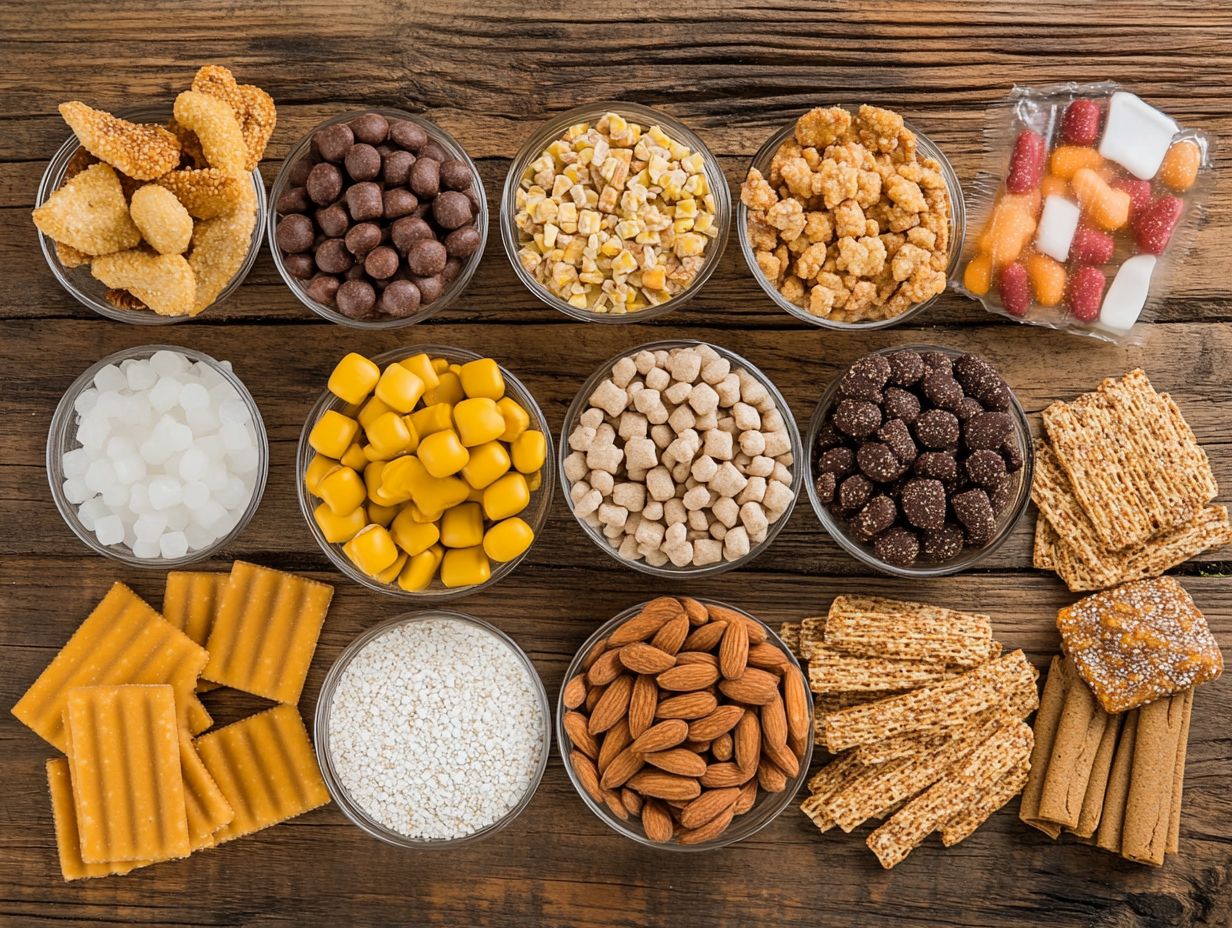
What ingredients should I avoid when looking for gluten-free snacks?
When searching for gluten-free snacks, avoid ingredients like:
- wheat
- barley
- rye
- any other grains containing gluten
Are there any additives or preservatives that should be avoided in gluten-free snacks?
Yes, some additives and preservatives may contain gluten. Others could be cross-contaminated.
These include maltodextrin, which is a thickening agent made from starch, modified food starch, which is processed starch used to improve texture, and natural or artificial flavors.
Is it safe to assume that all gluten-free snacks are free of cross-contamination?
No, it is not safe to assume. While a product may be labeled as gluten-free, it is important to still check for any cross-contamination warnings or statements on the packaging.
Always check the ingredient list! Even tiny amounts of gluten can sneak into your snacks, so stay vigilant.
Gluten can be hidden in products such as soy sauce, marinades, and seasonings.
Are there any specific types of gluten-free snacks that I should be aware of?
Yes, some gluten-free snacks may have grains or ingredients that are not typically associated with gluten. These include corn, quinoa, or tapioca.
If you have any concerns, be sure to research the ingredients or consult with a healthcare professional.
Can I trust products labeled as “gluten-free” from other countries or regions?
It is safer to choose products from your own country. Regulations and labeling can vary significantly elsewhere.
If you’re unsure, do some research or look for certification symbols on the packaging.

